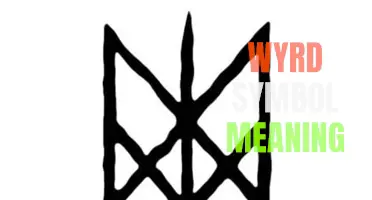
Look up to the sky, and you can see an ever-changing tapestry of clouds displayed across the horizon. While they may seem like mere puffs of vapor, these ethereal formations hold a deeper significance in the realm of symbolism. Cloud shapes have long been associated with messages, omens, and spiritual connections across various cultures and belief systems. From the fluffy cumulus clouds representing innocence and bliss to the ominous thunderheads signifying impending storms, each cloud shape holds its own symbolism and meaning waiting to be deciphered by those who dare to look up and wonder. So, let's embark on a journey through the celestial skies and explore the hidden depths of cloud shape symbolism.
What You'll Learn
- What are common cloud shapes and their symbolic meanings?
- How does the shape of a cloud affect its symbolic meaning?
- Are there cultural differences in the symbolism of cloud shapes?
- What is the significance of different cloud shapes in meteorology?
- How do artists and writers use cloud shape symbolism in their work?

What are common cloud shapes and their symbolic meanings?
Clouds are a natural phenomenon that have fascinated humans for centuries. Their ever-changing shapes and forms have inspired artists, poets, and dreamers alike. Clouds can take on various shapes, each with their own symbolism and meanings. Let's explore some of the common cloud shapes and their symbolic significance.
Cumulus Clouds:
Cumulus clouds are the classic white fluffy clouds we often associate with a beautiful sunny day. These clouds resemble cotton balls or cauliflower and generally have a flat base with a puffy or billowing appearance. Cumulus clouds symbolize optimism, happiness, and new beginnings. They are often seen as positive signs, indicating good fortune or a fresh start.
Stratus Clouds:
Stratus clouds are low-lying clouds that form long, thin layers or sheets across the sky. They usually appear gray or white and can cover the entire sky, blocking out the sun. Stratus clouds often symbolize gloominess or a sense of sadness. Their presence can indicate a period of reflection or introspection, urging individuals to slow down and take a moment to think.
Cirrus Clouds:
Cirrus clouds are delicate and wispy clouds that are high in the sky. They have a feathery or hair-like appearance and are often white or light gray. Cirrus clouds represent change, transformation, and ethereal beauty. They symbolize the fleeting nature of life and encourage individuals to embrace change and adapt to new circumstances.
Cumulonimbus Clouds:
Cumulonimbus clouds are massive and majestic, often reaching incredible heights. These clouds are associated with thunderstorms, lightning, and heavy rainfall. They have a towering, anvil-shaped top and a dark, ominous base. Cumulonimbus clouds symbolize power, intensity, and transformation. They remind us of the immense forces of nature and the importance of harnessing our own inner strength.
Lenticular Clouds:
Lenticular clouds are unique, lens-shaped clouds that form near mountains or hilly terrain. They are often stationary and have distinct, smooth edges. Lenticular clouds symbolize mystery, the unknown, and a sense of wonder. Their appearance can evoke a sense of curiosity and encourage individuals to explore different perspectives or embark on new adventures.
It is important to note that while cloud shapes can have symbolic meanings, they are also influenced by their context and the observer's personal interpretation. Therefore, the symbolism of clouds may vary depending on cultural beliefs, individual experiences, and personal associations.
In conclusion, clouds come in various shapes, each carrying its own symbolic significance. Whether they represent happiness, sadness, change, power, mystery, or something entirely unique to the observer, clouds continue to captivate our imagination and invite us to contemplate the wonders of the natural world. So, next time you find yourself gazing at the sky, take a moment to appreciate the beauty and symbolism of the clouds above.
The Ultimate Guide to Mitsubishi Shogun Dashboard Symbols and Meanings
You may want to see also

How does the shape of a cloud affect its symbolic meaning?
Clouds are one of nature's most intriguing and beautiful phenomena. They are constantly changing, always shifting and evolving in the sky. But did you know that the shape of a cloud can have symbolic meaning? Throughout history, different cultures have interpreted cloud formations in various ways, attaching significance to different shapes and patterns.
One of the most common cloud shapes is the cumulus cloud. These puffy, cotton-like clouds are often associated with fair weather and a carefree atmosphere. They are often seen as a symbol of childhood and innocence, evoking feelings of joy and lightness. Cumulus clouds also have a positive connotation, representing optimism and a positive outlook on life.
On the other hand, stratocumulus clouds, which are low-lying and layered, have a different symbolic meaning. These clouds are often associated with a gloomy or melancholic mood. They can represent feelings of sadness, heaviness, or a sense of impending doom. Stratocumulus clouds are often seen as a symbol of introspection and contemplation.
Another cloud shape that holds symbolic meaning is the cumulonimbus cloud, which is tall and towering. These clouds are often associated with thunderstorms and intense weather. They can represent feelings of power, strength, and unpredictability. Cumulonimbus clouds are often seen as a symbol of sudden change and upheaval.
Clouds can also take on symbolic meaning based on their colors. For example, dark clouds are often associated with sadness or danger. They can represent a looming threat or a difficult situation. On the other hand, fluffy white clouds are often seen as a symbol of purity and innocence. They can represent a sense of calm and tranquility.
In some cultures, clouds have been seen as a guiding force or a connection to the divine. For example, in ancient Greece, clouds were believed to be the dwelling place of the gods. In Native American cultures, clouds were seen as messengers from the spiritual realm. Clouds can symbolize the ethereal and the transcendent, representing a bridge between the earthly and the divine.
Overall, the shape of a cloud can affect its symbolic meaning in different cultures and contexts. Different cloud formations can represent different emotions, moods, and natural phenomena. From the carefree and optimistic cumulus clouds to the powerful and unpredictable cumulonimbus clouds, the shapes of clouds are a source of inspiration and symbolism throughout human history. So the next time you look up at the sky and see a cloud, take a moment to ponder its shape and the meaning it holds.
Decoding the Symbols: Understanding the Meaning Behind Night Owl Security Camera Symbols
You may want to see also

Are there cultural differences in the symbolism of cloud shapes?
Clouds have been a subject of fascination and interpretation throughout human history. Their unique shapes and formations have often been associated with different meanings and symbolism across different cultures. While many cultures share similar interpretations, there are also notable differences in the symbolism of cloud shapes.
In Western cultures, clouds are often seen as symbols of freedom, tranquility, and spirituality. They are often used in art and literature to evoke a sense of peace and ethereal beauty. Clouds are also associated with the divine realm, serving as pathways for gods and celestial beings.
In contrast, some Native American cultures see cloud shapes as messages from spirits or ancestors. They believe that the movement and formations of clouds can convey important messages about the natural world and future events. For example, the Lakota tribe sees cloud formations as a way to communicate with the Great Spirit and seek guidance.
In East Asian cultures such as China and Japan, clouds are seen as symbols of good fortune and luck. These cultures often depict clouds as symbols of abundance and prosperity, representing a bountiful harvest and successful endeavors. Cloud motifs can be found in traditional artwork, clothing, and even architecture, symbolizing positive energy and blessings.
In African cultures, cloud shapes often have a more practical interpretation. For instance, the Maasai people of East Africa use cloud formations to predict weather patterns and make decisions related to their nomadic lifestyle. They believe that certain cloud shapes can indicate the arrival of rain or the changing of seasons, guiding them in their pastoral activities.
It is important to note that these interpretations are not limited to specific cultures, and individuals within a culture may have their own personal associations with cloud shapes. Additionally, globalization and cultural exchange have led to the blending of symbolism and interpretations across cultures.
In conclusion, while there are cultural differences in the symbolism of cloud shapes, there are also shared themes and interpretations across different cultures. Clouds continue to captivate the human imagination, serving as a source of inspiration and symbolism throughout history. Whether as symbols of freedom, spiritual significance, good fortune, or practical indicators, clouds remain a universal and powerful motif in various cultures around the world.
Decoding the Symbols and Meanings of Caterpillar Heavy Equipment
You may want to see also

What is the significance of different cloud shapes in meteorology?
Clouds come in various shapes and sizes, and each shape carries significant meaning in the field of meteorology. From fluffy cumulus clouds to flat stratus clouds, the appearance of clouds can provide valuable insights into the weather conditions. Meteorologists rely on cloud shapes to make predictions about temperature, rainfall, wind speed, and other meteorological phenomena.
One of the most common cloud shapes is cumulus clouds. These are characterized by their puffy, cotton-ball-like appearance, often described as resembling cauliflower or popcorn. Cumulus clouds indicate fair weather conditions, with sunny skies and little to no precipitation. They tend to form during the daytime when the sun's heat causes warm air to rise and condense. However, if cumulus clouds start to grow vertically and become taller, they might develop into cumulonimbus clouds, which can bring thunderstorms and heavy rainfall.
Stratus clouds, on the other hand, are low-lying clouds that stretch across the sky like a blanket. They have a uniform, flat appearance and often cover the entire sky. Stratus clouds are associated with overcast conditions and can bring drizzle or light rain. Due to their flat shape, they can also indicate stable atmospheric conditions and sometimes linger for long periods.
Cirrus clouds are high-altitude clouds that appear thin and wispy. They often have a feathery appearance and can stretch across the sky in long, curved lines. Cirrus clouds are composed of ice crystals and are usually found at altitudes above 20,000 feet. Their presence indicates fair weather or the approach of a warm front, as they often precede the arrival of more significant weather systems.
Another cloud shape of interest to meteorologists is the stratocumulus cloud. These clouds appear as layers or patches of rounded, lumpy clouds. They often cover large portions of the sky and can be gray or white. Stratocumulus clouds usually form in stable atmospheric conditions and are sometimes associated with light precipitation or drizzle. However, they can also dissipate quickly, leading to clearing skies.
In addition to these cloud shapes, meteorologists pay attention to other characteristics such as the color and thickness of clouds. Thick, dark clouds often indicate the presence of moisture and the potential for heavy rainfall. Lighter-colored clouds, on the other hand, suggest drier conditions and less chance of precipitation.
Overall, cloud shapes play a crucial role in meteorology as they provide visual clues about current and future weather conditions. By observing and analyzing the different cloud shapes, meteorologists can refine their forecasts and warn people about impending storms or sunny weather. So, the next time you look up at the sky and see a specific cloud shape, remember that it holds valuable information about the atmospheric conditions and can help you prepare for what's to come.
Decoding the Nissan Armada Dashboard Symbols and Their Meanings
You may want to see also

How do artists and writers use cloud shape symbolism in their work?
Clouds are more than just fluffy masses in the sky; they have long been used as powerful symbols in art and literature. Artists and writers have often used cloud shape symbolism to represent various themes and ideas in their work.
One common way that cloud shape symbolism is used is to convey a sense of freedom and escape. Clouds are often seen as floating and ethereal objects, and their shape can evoke feelings of lightness and transcendence. Artists and writers use this symbolism to convey a desire to break free from the constraints of reality and explore new horizons. For example, in the famous novel "To Kill a Mockingbird" by Harper Lee, the character of Scout often gazes at the clouds and daydreams about the adventures that lie beyond her small town.
Clouds can also symbolize a sense of mystery and uncertainty. Their shape is ever-changing and can be interpreted in various ways. This symbolism is often used in works of art and literature to create an atmosphere of suspense and intrigue. For example, in the painting "The Persistence of Memory" by Salvador Dali, the melting clocks and surreal landscape are juxtaposed with a cloudy sky, creating an unsettling and dreamlike atmosphere.
Furthermore, cloud shape symbolism is often used to represent emotions and moods. Clouds can be dark and stormy, symbolizing sadness or anger, or they can be light and fluffy, symbolizing joy or peace. This symbolism is often used by artists and writers to convey the inner turmoil or serenity of their characters. For example, in the play "Macbeth" by William Shakespeare, the character of Macbeth sees a floating dagger in the sky, which is described as "a dagger of the mind, a false creation, proceeding from the heat-oppressed brain." The cloud shape of the dagger represents Macbeth's troubled and tormented state of mind.
In addition to these symbolic meanings, cloud shape symbolism can also be used to represent nature and the environment. Clouds are a natural phenomenon that constantly changes and transforms the sky. Artists and writers often use this symbolism to convey a sense of the ever-changing and interconnected nature of the world. For example, in the poem "I Wandered Lonely as a Cloud" by William Wordsworth, the poet describes a field of golden daffodils that "flutter and dance in the breeze" like clouds in the sky. The cloud shape of the daffodils represents their transient beauty and their connection to the natural world.
In conclusion, cloud shape symbolism is a powerful tool that artists and writers use to convey a variety of themes and ideas in their work. Whether representing freedom, mystery, emotions, or nature, clouds have the ability to evoke certain feelings and create a deeper connection between the audience and the artwork or literature. So, the next time you see clouds floating in the sky, take a moment to appreciate the symbolism they hold and the stories they can tell.
Understanding Forklift Dashboard Symbols and Meanings: A Guide for Operators
You may want to see also
Frequently asked questions
In dreams, a cloud shape can often symbolize a sense of mystery or ambiguity. Clouds are often associated with the subconscious mind, and their ever-changing forms can represent the shifting and sometimes hidden aspects of our thoughts and emotions. Dreams involving clouds may suggest the need for greater clarity or understanding in a particular situation, or they may indicate a sense of uncertainty or confusion in one's waking life.
Cloud shapes are a common motif in art and literature and can carry various meanings depending on the context. In some cases, clouds may symbolize transcendence or the spiritual realm, representing a connection to something greater than oneself. They can also evoke a sense of freedom or escape, with their billowy forms suggesting the ethereal and intangible nature of dreams and aspirations. Additionally, clouds can symbolize transformation or change, reflecting the transient and ever-shifting nature of life.
In weather forecasting, different cloud shapes and formations can provide valuable information about upcoming weather conditions. For example, a cumulus cloud with a cauliflower-like appearance often indicates fair weather, while a towering cumulonimbus cloud with an anvil shape may signal the potential for thunderstorms or severe weather. Stratus clouds, which are low and flat, are often associated with overcast skies and drizzle, while cirrus clouds, which are high and wispy, can indicate fair weather or the approach of a warm front. By observing and interpreting these cloud shapes, meteorologists can make predictions about the weather patterns ahead.







